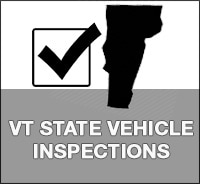
 802 Toyota is a Vermont state approved inspection station.
802 Toyota is a Vermont state approved inspection station.
What's involved in the inspection of your vehicle?
The following is a list of vehicle components that will be checked and steps taken by our service department during the inspection of your vehicle:
Vehicle Documentation:
- Fill out vehicle work order for inspection
- Verify registration certificate is current, accurate, and in agreement with vehicle
- Verify insurance document is current, accurate, and in agreement with vehicle
-
Verify public VIN on vehicle dashboard and match to vehicle documentation
Safety:
-
Verify vehicle is equipped with seat belts (1964 & newer) and verify functionality
Body:
- Check interior rearview mirror
- Check exterior rearview mirror
- Check windshield wipers for correct operation and condition of blades
- Check bumpers and fenders
- Check for protruding metal
-
Check for sun visors
Tires & Wheels:
- Measure tires for wear
- Check tires for cuts, snags, and cracks
- Check tires for bumps, bulges, and knots
- Check tire labeling for restricted usage
- Check wheel bolts, nuts, or lugs
- Check wheel for damage
- Check function of TPMS system
- Check for proper tire size
- Check for proper inflation
-
Ensure tires do not protrude past fender walls
Steering & Suspension:
- Check for lash or free play in steering system
- Check power steering system for operation, fluid level, and leaks
- Check ball joints for movement
- Check ball joint assembly for seizure due to rust
- If ball joint movement is detected, check tolerance with tool (use manufacturer spec's)
- Check torsion bars or springs
- Check tire rod ends
- Check tie rods for seizure due to rust
- Check condition of shock absorbers and struts
- Check wheel bearings
-
Check axle shaft
Brakes:
- Check for brake failure and ABS indicator lamp operation
- Check brake system integrity
- Check parking brake functionality
- Check brake failure lamp
- Check master cylinder lines and wheel brakes for signs of leakage
- Check brake hoses for integrity, cracks, and wear
- Road test brakes (stop within 25 feet at 20 mph)
-
Verify critical vehicle instrumentation (odometer & speedometer)
Lighting & Electrical System:
- Perform a visual check of all lamp functionality
- Ensure fog and driving lights illuminate with corresponding headlight beams
- Check headlight aim
- Check switches and functions of directional controls
- Check defroster function
- Check horn function
- Check for exposed wiring for damage and poor connections
- Check lights for cracks, leaks, or insufficient repairs
- Check for unauthorized after-market lighting
-
Check airbag readiness light
Glass:
- Check windshield glass for cracks, chips, and discoloration
- Check left front window for visibility and operation of all windows
- Check for incorrect sticker placement or other visual restrictions
-
Check glass to the left & right of the driver position for after-market tinting
Body:
- Check integrity of floor pan and trunk area
-
Check frame and body mounts
Exhaust System:
- Check vehicle muffler
- Check for after-market uncertified muffler
- Check for loose joints or leaking joints
- Check for leaks caused by corrosion, seams, or patches on muffler or tailpipe
- Check tailpipe end for restrictions
- Check for exhaust system modifications allowing excessive noise
-
Ensure no part of the exhaust system passes through the passenger compartment
Fuel System:
- Ensure system is securely attached
- Check for vapor or fuel leakage
- Check for proper routing of fuel lines
-
Check fuel tank and/or auxiliary fuel tank, or jug stored in vehicle
Emission System:
- Check catalytic converter if so equipped
- Ensure fuel cap is present and secure
- Perform OBDII check (1996 & newer vehicles - use CAN protocol scan tool)
-
Fill out OBDII form
Paperwork:
- Fill out inspection sticker, use correct numeric insert & affix to vehicle
- Fill out inspection log sheet
The On-Board Diagnostics (OBDII) Inspection
OBD technology benefits motorists, automotive service technicians, and our environment. It is beneficial for motorists because it monitors the vehicle's performance every time it is driven and identifies problems immediately, allowing repairs to be made before more serious problems develop. It is beneficial for technicians because it helps them to accurately diagnose problems, allowing for efficient and proper repairs. And it is beneficial for our environment and our health because it identifies problems that cause vehicle emissions to increase.
What does the OBD check involve?
First, the vehicle is checked to see if the Malfunction Indicator Light ("MIL", commonly called the "check engine" or "service engine soon" light) on the instrument panel illuminates when the ignition key is turned to the "on" position and then when the engine is running. Next, an electronic device known as a scan tool is connected to the vehicle, and used to communicate with the vehicle's on-board computer. The on-board computer is checked to confirm that the vehicle has completed it's self-tests, to determine if the computer has attempted to turn on the Malfunction Indicator Light, and if applicable, to retrieve diagnostic trouble codes. The results are recorded (see sample of blank form below), and the scan tool is disconnected from the vehicle. The entire OBD check typically takes less than 5 minutes.
Contact
802 Toyota
30 Berlin Mall Road
Berlin, VT 05602
- Sales: 802-229-9117
- Service: 802-224-7265
- Parts: 802-224-7270
 802 Toyota is a Vermont state approved inspection station.
802 Toyota is a Vermont state approved inspection station.